Collection of materials relating to neuro-ophthalmology as part of the Neuro-Ophthalmology Virtual Education Library.
NOVEL: https://novel.utah.edu/
TO
- NOVEL977
Filters: Collection: "ehsl_novel_novel"
| Title | Creator | Description | Subject | ||
|---|---|---|---|---|---|
| 1 |
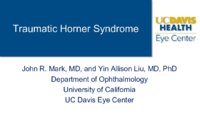 |
Traumatic Horner Syndrome | John Robert Mark; Yin Allison Liu | This presentation is a discussion about the presentation of traumatic Horner syndrome (AKA "Oculosympathoparesis") and the emergent next steps that should be taken. The discussion highlights the varying presentations and gives an example of a patient who suffered an injury to the neck resulting in a... | Horner Syndrome; Horners; ICA Dissection; Internal Carotid Artery Dissection; Miosis, Oculosympathetic Paresis; Oculosympathoparesis; Preganglionic; Ptosis; Pupillary Pathology; Second-order Injury; Traumatic Horner Syndrome |
| 2 |
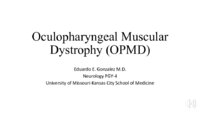 |
Oculopharyngeal Muscular Dystrophy (OPMD) | Eduardo Gonzalez; Sean Gratton | This is a brief review of Oculopharyngeal Muscular Dystrophy. It includes a review of the background, pathophysiology, epidemiology, diagnosis, and management of the disorder. The key clinical features including ptosis and dysphagia are reviewed in detail. | Chronic Progressive External Ophthalmoplegia; Dysphagia; Muscular Dystrophy; Myasthenia Gravis; Oculopharyngeal Muscular Dystrophy; Ptosis |
| 3 |
 |
A Suspected Case of Wildervanck Syndrome | Hari R. Anandarajah; Tejaswini K. Deshmukh; Ryan D. Walsh | A 5-year-old male with congenital right-sided hearing loss presented to the neuro-ophthalmology clinic for strabismus evaluation. He had longstanding bilateral abduction deficits with associated esotropia, for which he underwent bilateral medial rectus recessions at age three. He had persistent limi... | Cervico-oculo-acoustic Syndrome; Congenital Deafness; Duane Syndrome; Klippel-Feil Cervical Anomaly; Wildervanck Syndrome |
| 4 |
 |
Chronic Migraine | Olivia Liu; Sean Gratton | This narrated powerpoint is a review of Chronic Migraine. This includes a review of the pathophysiology of migraine and what contributes to the chronicity of migraine. Treatments of chronic migraine are also reviewed. | Central Sensitization; Chronic Migraine; Migraine |
| 5 |
 |
Aqueous and Vitreous Humor | Ryung San Lee; Amanda Dean Henderson | Multiple choice test set administered to test comprehension of "Aqueous and vitreous humor" sub-section of NANOS Illustrated Curriculum for Neuro-Ophthalmology. The topics in this submission cover questions related to anatomical and physiologic concepts in aqueous and vitreous humor. More specifical... | Anatomy; Aqueous Humor; Vitreous Humor |
| 6 |
 |
Myelin Oligodendrocyte Glycoprotein Antibody Associated Disease (MOGAD) Revisited | Zahir Sheikh; Michael Gilhooley | The purpose of this presentation is to review the varied clinical manifestations of MOGAD for the neurology and neuro-ophthalmology providers. | Demyelinating; MOG; MOGAD; Myelin |
| 7 |
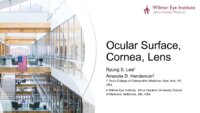 |
Ocular Surface, Cornea, Lens | Ryung San Lee; Amanda Dean Henderson | Multiple choice questions set from the NANOS Illustrated Curriculum for Neuro-Ophthalmology. This question set is meant to accompany the video lecture on the anatomy of the ocular surface, cornea, and lens. The ocular surface is a complex topic and pertinent to the comprehensive ophthalmic care prov... | Cornea; Ocular Surface; Uvea |
| 8 |
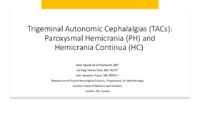 |
Trigeminal autonomic cephalalgias (TACs): Paroxysmal hemicrania (PH) and hemicrania continua (HC) | Jihad Yaqoob Ali Al Kharbooshi; Tommy Lik Hang Chan; J. Alexander Fraser | In this narrated slideshow, we describe the pathophysiology, epidemiology, diagnostic criteria, subtypes, workup, and management of hemicrania continua (HC) and paroxysmal hemicrania (PH). | Hemicrania Continua; Paroxysmal Hemicrania; TAC, Trigeminal Autonomic Cephalalgia |
| 9 |
 |
Other Trigeminal Autonomic Cephalalgias (TACs) | Jihad Yaqoob Ali Al Kharbooshi; Tommy Lik Hang Chan; J. Alexander Fraser | In this narrated slideshow, we review the pathophysiology, epidemiology, differential diagnosis, diagnostic criteria, subtypes, and management of the other trigeminal autonomic cephalalgias (cluster headache and the SUNHA syndromes). It is a companion to our earlier slideshow, "Trigeminal autonomic ... | Indomethacin; SUNA; SUNCT; SUNHA; TAC; Trigeminal Autonomic Cephalalgia |
| 10 |
 |
Genetic Causes of Isolated Optic Neuropathy | Kathleen Ho; Devin Mackay | Overview of isolated genetic optic neuropathies and their neuro-ophthalmic manifestations with an illustrative case example and discussion of clinical presentation, relevant biochemistry, and testing. | Genetics; Hereditary; MFN2; NDUFV1; OPA1; OPA3; Optic Atrophy; Optic Neuropathy; POLG; SPG7; WFS1 |
| 11 |
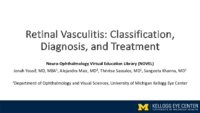 |
Retinal Vasculitis: Classification, Diagnosis, and Treatment | Jonah Edward Yousif; Alejandra M. Maiz; Thérèse Maria Sassalos; Sangeeta Khanna | This manuscript discusses retinal vasculitis and its classification, diagnosis, and treatment. We first discuss the definition and symptoms of retinal vasculitis followed by its classification as a small-vessel vasculitis compared to large and medium vessel vasculitides. Following this, we describe ... | Fluorescein Angiography; Retina; Retinal Vasculitis; Uveitis; Vasculitis |
| 12 |
 |
Macular Edema | Stephanie Chau Nguyen; James Brian Davis; Amanda Dean Henderson | Macular edema can result from pathologic extravasation of fluid through blood vessels in the macular region. This can be a feature of heritable diseases like dominantly inherited cystoid macular edema or acquired causes such as diabetic retinopathy, hypertensive retinopathy, retinal vein occlusions,... | Anti-VEGF; Diabetes; DME; Macular Edema; OCT |
| 13 |
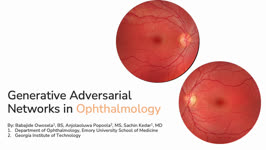 |
Generative Adversarial Networks in Ophthalmology | Babajide Olubusayo Owosela; Anjolaoluwa Popoola; Sachin Kedar | In this video we will describe Generative Adversarial Networks (GAN) models and its applications and limitations in Ophthalmology. GAN, a technique within machine learning, enables computers to utilize real data to generate valuable synthetic data, artificially produced information that mimics the s... | Artificial Intelligence; Generative Adversarial Networks; Machine Learning; Synthetic Data |
| 14 |
 |
NANOS Illustrated Curriculum Section B Introduction | Jason Peragallo, MD | Introduction video to the resources available in Section B of the NANOS Illustrated Curriculum. | Afferent visual pathway; Efferent visual pathway, Pupillary visual pathway; Examination |
| 15 |
 |
Paraneoplastic Anti-Hu and Anti-CV2 Positive Ataxic (Cerebellar and Sensory Ganglionopathy) Encephalitis | Anuj Rastogi; Rahul Sharma; Gustavo Saposnik; Alexandra Muccilli | We describe a case of an elderly man with Non-small Cell Lung Cancer, presenting with paraneoplastic Anti-Hu and Anti-CV2 positive encephalitis. He had both cerebellar ataxia and sensory ataxia, likely from the paraneoplastic induced cerebellar degeneration and sensory ganglionopathy, respectively. ... | Anti-CV2; Anti-Hu; Ataxia; Cerebellar Ataxia; Encephalitis; Nystagmus; Sensory Ganglionopathy |
| 16 |
 |
Age Related Macular Degeneration | Riya H. Patel; James Brian Davis; Amanda Dean Henderson | Age-related macular degeneration (AMD) is a degenerative disease of the retina that causes central vision loss, and it is the leading cause of blindness in the developed world. Age is a strong nonmodifiable risk factor for AMD. Patients may have genetic susceptibility to AMD from mutations in genes ... | AMD; AREDS2; Exudative; Geographic Atrophy; Macular Degeneration; Nonexudative |
| 17 |
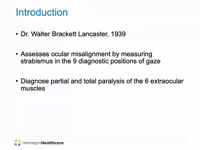 |
Lancaster Red-Green Test | Angela Cao; Anne Abel | The Lancaster Red Green Test is used to assess ocular misalignment. This brief video explains how to administer and interpret the test. | Diplopia; Lancaster Red Green Test; Strabismus |
| 18 |
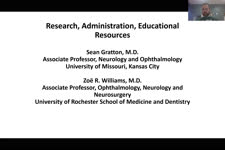 |
NANOS Illustrated Curriculum Section H Introduction | Sean Gratton, MD; Zoë R. Williams, MD | Introduction video to the resources available in Section H of the NANOS Illustrated Curriculum. | History, Neuro-ophthalmology; Principles of Practice, Neuro-Ophthalmology; Systems of Healthcare; Research, Neuro-ophthalmology |
| 19 |
 |
NANOS Illustrated Curriculum Section D Introduction | Meagan D. Seay, DO; Victoria S. Pelak, MD | Introduction video to the resources available in Section D of the NANOS Illustrated Curriculum. | Lesions, Afferent Visual Pathway; Disorders, Afferent Visual Pathway; Pupillary Anatomy; Disorders, Pupillary Function; Lesions, Efferent Visual Pathway; Ocular Motility; Abnormal Eye Movements; Eyelids; Abnormal Facial Movements |
| 20 |
 |
NANOS Illustrated Curriculum Section G Introduction | Meagan D. Seay, DO | Introduction video to the resources available in Section G of the NANOS Illustrated Curriculum. | Obesity, Management; Low Vision, Management; Genetic Diseases, Management; Patient Counseling |
| 21 |
 |
Facioscapulohumeral Muscular Dystrophy (FSHD) | Rohith Erukulla; Brooke Johnson | This is an introduction to Facioscapulohumeral Muscular Dystrophy (FSHD) and its causes, presentation, diagnosis, treatment, and ongoing related research. | Dystrophy; Facioscapulohumeral Muscular Dystrophy; FSHD; Myopathy |
| 22 |
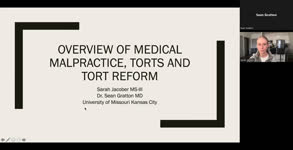 |
Overview of Medical Malpractice, Torts, and Tort Reform | Sarah Jacober; Sean Gratton | This is a brief narrated powerpoint, which serves as an introduction to the basics of medical malpractice. The definition and history of medical malpractice are explored. The relationship between medical malpractice and tort law are explained, and tort reform is introduced. | Lawsuit; Malpractice; Medical Malpractice; Medicolegal; Tort Reform; Torts |
| 23 |
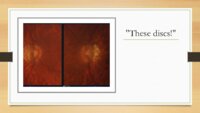 |
Tilted-Disc Syndrome (TDS) - Understanding the Basics | Ahmed Alshaikhsalama; Melanie Truong-Le | This submission is a powerpoint summarizing the literature on a poorly understood disorder known as Tilted Disc Syndrome (TDS). Delving into the fundamental aspects of TDS, this resource meticulously digests complex medical literature to inform readers on the epidemiology, risk factors, complication... | Coloboma; Inferior Crescent; Tilted Disc Syndrome |
| 24 |
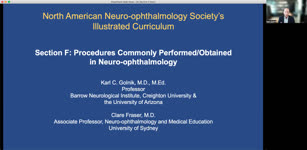 |
NANOS Illustrated Curriculum Section F Introduction | Karl C. Golnik, MD, MEd; Clare Fraser, MD | Introduction video to the resources available in Section F of the NANOS Illustrated Curriculum. | Surgery, Ophthalmic; Surgery, Neurological; Non-surgery procedures; Neurosurgery; Interventional neuroradiology; Neuro-ablation; Neuro-stimulation; Intraocular surgery; Botulinum toxin therapy |
| 25 |
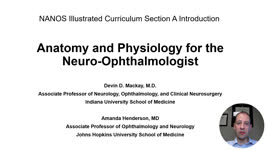 |
NANOS Illustrated Curriculum Section A Introduction | Devin D. Mackay, MD; Amanda D. Henderson, MD | Introduction video to the resources available in Section A of the NANOS Illustrated Curriculum. | Anatomy, Visual Pathways; Anatomy, Eye; Anatomy, Orbit; Anatomy, Intracranial; Anatomy, Orbital Vascular; Cerebrospinal fluid |
| 26 |
 |
The Mystery of Zero Ishihara Plates with 20/20 Vision | Vivian Paraskevi Douglas; Konstantinos Douglas; Nurhan Torun | Herein we present a case of 71-year-old retired teacher who presented with difficulty reading over the past year. On examination, the patient had difficulty identifying even the control plate on Ishihara testing in both eyes (OU), despite intact color recognition. Humphrey visual field testing revea... | Simultanagnosia; Neurodegeneration; Posterior Cortical Atrophy |
| 27 |
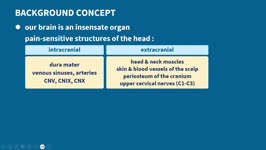 |
Headache Associated With Low or High Intracranial Pressure | Yu Hsin Chen; Amanda Dean Henderson; James Brian Davis | When intracranial pressure changes, the most common symptom is headache, which often has a positional component. We introduce various etiologies of headaches attributed to increased or low intracranial pressure, with idiopathic intracranial hypertension (or primary pseudotumor cerebri), post-dural p... | CSF Leak; Headache; Intracranial Hypertension; Intracranial Hypotension; Papilledema; Pseudotumor Cerebri |
| 28 |
 |
A Case of Left Facial Pain Misdiagnosed as Migraine Headache | Hong Jiang | A 58-year-old female sought a second opinion due to a two-year duration of sporadic left facial pressure pain, along with irritation and dryness in her left eye. She has a well-documented history of episodic migraines characterized by throbbing headaches on the right side. She had been under the car... | Dry Eye; Facial Nerve Schwannoma; Facial Pain |
| 29 |
 |
Trigeminal Autonomic Cephalgias | Kaitlin Keenan; Aimee J. Szewka | These slides are a comprehensive discussion addressing Trigeminal Augonomic Cephalgias - in particular, Cluster Headaches, Paroxysmal Hemicrania, Hemicrania Continua and Short-Lasting Unilateral Neuralgiform Headache Attack (SUNHA). Our slides discuss diagnosis, prognosis and treatment of these rare... | Cluster Headache; Headache; Hemicrania Continua; Paroxysmal Hemicrania; Short-Lasting Unilateral Neuralgiform Headache Attack; Trigeminal Autonomic Cephalgia |
| 30 |
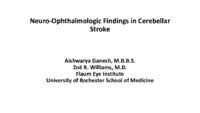 |
Neuro-ophthalmologic Findings in Cerebellar Stroke | Zoe Rebecca Williams; Aishwarya Ganesh | This PowerPoint reviews the anticipated neuro-ophthalmologic findings in cerebellar strokes including posterior inferior cerebellar artery (PICA), anterior inferior cerebellar artery (AICA) and superior cerebellar artery (SCA) territory infarcts. The review includes discussion of potential ocular mi... | AICA; Cerebellar Esotropia; Cerebellar Infarct; Lateral Medullary Syndrome; Nystagmus; Ocular Lateropulsion; PICA; SCA; Skew Deviation |
| 31 |
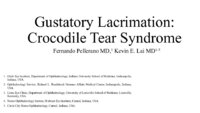 |
Gustatory Lacrimation: Crocodile Tear Syndrome | Fernando Pellerano; Kevin Lai | We describe a case of gustatory lacrimation on a 61-year-old male with a history of Bell's Palsy that presented to the Ophthalmology clinic with painless epiphora in the right eye while eating. Examination was notable for oral-ocular synkinesis and hyperlacrimation while eating on the right eye only... | Crocodile Tear Syndrome; Gustatory Lacrimation; Oral-ocular Synkinesis |
| 32 |
 |
Hydroxychloroquine Retinopathy | Zoe Rebecca Williams, MD; David Allen DiLoreto Jr., MD | This powerpoint reviews hydroxychloroquine retinopathy including the clinical findings and the updated American Academy of Ophthalmology screening guidelines (revised in 2016). It includes images depicting the typical paracentral visual field loss, spectral domain optical coherence tomography findin... | AAO Screening Guidelines; Fundus Autofluorescence; Hydroxychloroquine Retinopathy; Outer Nuclear Layer Loss; Photoreceptor Loss; Retinal Pigment Epithelium Loss; Spectral Domain Optical Coherence Tomography |
| 33 |
 |
Diagnosis and Evaluation of Stroke in the Pons | Padmaja Sudhakar; Fatai Momodu | This short power point describes the anatomy of the pons, followed by description of stroke in the pons along with clinical presentation and work up. | Crossed Signs; One and Half Syndrome; Pontine Stroke |
| 34 |
 |
Financial Social Legal Implications of Genetic Testing | Jonathan Thomas; James Brian Davis | Genetic testing looks for mutations in DNA and can give insight into genetic diseases. Costs associated with genetic testing are the testing itself, as well as genetic counseling. Test results may lead to further considerations, which may impact finances. Genetic test results can have a social impac... | Financial; Genetic Information Nondiscrimination Act of 2008; Genetic Testing; Legal; Social |
| 35 |
 |
Injury Prevention in the Visually Impaired | Jonathan Thomas; James Brian Davis; Amanda Dean Henderson | With an aging population in the US, the number of those with visual impairments is also rising. Visual impairments increase the risk of falls, injuries, and other deficiencies, but there are several potential strategies to prevent these injuries. Members of the healthcare team can help visually impa... | Fall; Injury Prevention; Low Vision Specialist; Visually Impaired |
| 36 |
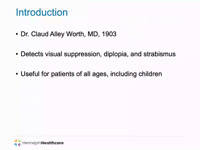 |
Worth 4-Dot Test | Angela Cao; Anne Abel | This presentation describes the Worth 4-Dot test, demonstrates how to perform the test, and interpret results. | Amblyopia; Diplopia; Worth 4-dot Test |
| 37 |
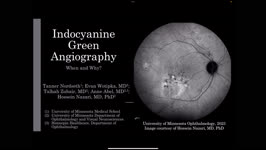 |
Idocyanine Green Angiography | Tanner Nordseth; Evan Wotipka; Talhah Zubair; Anne Abel; Hossein Nazari | This narrated PowerPoint presentation gives an overview of idocyanine green angiography. Historical significance, diagnostic utility, and comparison to fluorescein angiography are discussed. | Angiography; Choroidal imaging; Idocyanine green |
| 38 |
 |
Sixth nerve palsy or not? (Image) | Vivian Paraskevi Douglas; Konstantinos Douglas; Nurhan Torun | Here in we present a case of a 72-yearold Caucasian female with remote history of breast cancer who presented with diplopia in the right gaze over the past several months. There had been no improvement after a 5-day course of steroids by an outside ophthalmologist. On neuro-ophthalmic examination, t... | Abduction deficit; Diplopia; Orbital imaging |
| 39 |
 |
Sixth nerve palsy or not? (Video) | Vivian Paraskevi Douglas; Konstantinos Douglas; Nurhan Torun | Here in we present a case of a 72-yearold Caucasian female with remote history of breast cancer who presented with diplopia in the right gaze over the past several months. There had been no improvement after a 5-day course of steroids by an outside ophthalmologist. On neuro-ophthalmic examination, t... | Abduction deficit; Diplopia; Orbital imaging |
| 40 |
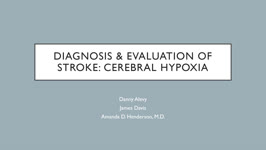 |
Diagnosis and Evaluation of Stroke: Cerebral Hypoxia | Danny Alevy; James Brian Davis; Amanda Dean Henderson | Neurons are particularly vulnerable to oxygen deprivation. Cerebral hypoxia can be caused by arterial thrombosis, embolism, hypoperfusion, cervical artery dissection, or cryptogenic causes. About 1/3 of ischemic strokes are from cryptogenic causes. Embolic strokes are the next most common (20-30%), ... | Atherosclerosis; Cerebral Hypoxia; Cervical Artery Dissection; Cryptogenic Ischemia; Embolism; Hypoperfusion; Ischemia; Stroke; Thrombosis |
| 41 |
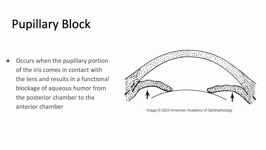 |
Pupillary Block | Sujata Dalal; James Brian Davis; Amanda Dean Henderson | Pupillary block occurs when the pupillary margin of the iris contacts the anterior surface of the lens. This creates a barrier for the outflow of aqueous humor from the posterior chamber to the anterior chamber and resultant increased pressure in the posterior chamber. This pressure can cause the ir... | Angle-Closure Glaucoma; Iris Bombe; Narrow Angle; Pupillary Block |
| 42 |
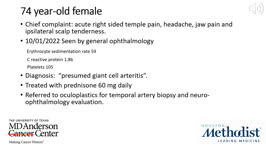 |
Behind the Mask | Pame Dávila; Nagham Al-Zubidi | Case report describing temporal artery amyloidosis masquerading as giant cell arteritis. | Giant cell arteritis; Temporal arteritis; Temporal artery amyloidosis |
| 43 |
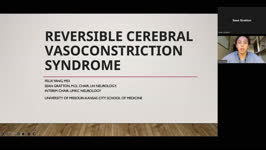 |
Reversible Cerebral Vasoconstriction Syndrome (RCVS) | Felix Yang; Sean Gratton | This is a narrated powerpoint that reviews Reversible Cerebral Vasoconstriction syndrome. It discusses the diagnostic basics and evaluation and management. It compares RCVS to Posterior Reversible Encephalopathy Syndrome (PRES). | Primary Angiitis of the Central Nervous System; Reversible Cerebral Vasoconstriction Syndrome; Subarachnoid Hemorrhage; Thunderclap Headache |
| 44 |
 |
Glaucoma: Evaluation and Principles of Management | Anand Haran; Sean Gratton | This is a narrated powerpoint that reviews the basics of glaucoma. It covers Primary Open Angle Glaucoma and Angle Closure Glaucoma, and includes reviews of the pathophysiology, evaluation, and management | Angle Closure Glaucoma; Glaucoma; Primary Open Angle Glaucoma |
| 45 |
 |
Neuro-Ophthalmic Complications of Chemotherapy | Nagham Al-Zubidi; May Ameri | This lecture covers the effect of antineoplastic chemotherapy, which can cause damage to the optic nerve and the ocular motor nerves. | Antineoplastic Chemotherapy; Ocular Motor Nerve Damage; Optic Atrophy; Optic Nerve Damage; Optic Nerve Edema; Optic Neuritis |
| 46 |
 |
Chorioretinal Coloboma | Kirstyn Taylor; Drew Scoles, MD | Coloboma is a term used to describe defects seen in various ocular structures due to incomplete embryologic development. Fundus coloboma specifically is due to failure of the embryonal fissure to close, which typically occurs by 5-7 weeks gestation. Posterior colobomas, involving the retina, choroid... | Chorioretinal; Coloboma; Optic Nerve |
| 47 |
 |
Intracranial Hemorrhage: Classification and Mechanisms | Victoria S. Pelak, MD | Intracranial hemorrhages can be life-threatening events. Classification of hemorrhages depends on the anatomical location, which also determines the associated risk factors for the hemorrhage. Descriptions of each type of hemorrhage and important aspects of the pathophysiology and risk factors are p... | Intracranial Hemorrhage |
| 48 |
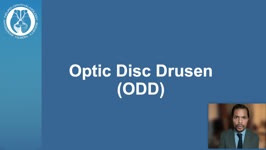 |
Patient Portal: Optic Disc Drusen | Cristiano Oliveira, MD | Optic disc drusen (ODD) are abnormal deposits of benign, usually calcified material within the optic disc, which is the front part of the optic nerve that connects each eye to the brain. We do not know the exact cause of optic disc drusen. They are present in 0.3-2% of people as an isolated case or ... | Optic disc drusen; Papilledema; Pseudopapilledema |
| 49 |
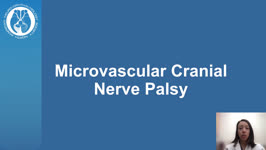 |
Patient Portal: Microvascular Cranial Nerve Palsy | Meagan Seay, DO | A nerve palsy is an impairment in the function of a nerve, which results in a decrease in function of the corresponding muscles controlled by that nerve. In microvascular cranial nerve palsy, something affects the blood supply to one of the cranial nerves, causing it not to work. This is usually the... | Nerve palsy; Microvascular cranial nerve palsy; Cranial nerve 3; CN3; Oculomotor nerve; Cranial nerve 4; CN4; Trochlear nerve; Cranial nerve 6; CN6; Abducens nerve |
| 50 |
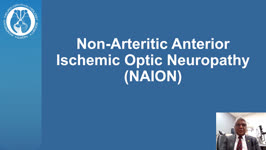 |
Patient Portal: Non-Arteritic-Anterior Ischemic Optic Neuropathy (NAION) | Arun Sundaram, MD | Non-arteritic anterior ischemic optic neuropathy (NAION or NA-AION) is caused by decreased blood flow to the front part of the optic nerve (optic disc). It causes optic nerve swelling and sudden vision loss. NAION typically affects one eye, although the other eye sometimes suffers similar loss month... | Non-arteritic anterior ischemic optic neuropathy; NAION; NA-AION; Optic nerve; Optic disc; Ophthalmic artery |
| 51 |
 |
Patient Portal: Myasthenia Gravis | Aroucha Vickers, DO | Myasthenia gravis (MG) is an autoimmune disease in which the body's immune system creates antibodies (proteins that normally protect us) that may attack receptors on your muscles. This results in muscle weakness because the muscles do not receive the signals to contract (tighten). Muscles anywhere w... | Myasthenia gravis; Ptosis; Double vision |
| 52 |
 |
Patient Portal: Giant Cell Arteritis | Anne S. Abel, MD | Giant cell arteritis is an inflammatory condition that can cause vision loss, double vision, fever, new persistent headaches, scalp tenderness, and jaw pain with chewing. GCA is caused by inflammation of blood vessels, primarily in the head and neck. Sometimes called "temporal arteritis," GCA frequ... | Giant cell arteritis |
| 53 |
 |
Patient Portal: Idiopathic Intracranial Hypertension (IIH) | Devin D. Mackay, MD | Idiopathic intracranial hypertension (IIH), also called pseudotumor cerebri, is a condition in which there is high pressure in the fluid surrounding your brain, spinal cord and optic nerves. This can cause headaches and problems with vision. Although the cause(s) of the condition is not fully unders... | Idiopathic intracranial hypertension; Pseudotumor cerebri |
| 54 |
 |
Patient Portal: Homonymous Hemianopsia | James C. O'Brien, MD | Homonymous hemianopia refers to an absence of vision towards one side of the visual world in each eye. The damage that caused this problem is in the brain and not in the eyes. | Homonymous hemianopia; Visual pathway |
| 55 |
 |
Patient Portal: Optic Neuritis | Anthony Brune, DO | Optic neuritis is inflammation of the optic nerve. In optic neuritis, the covering around the fibers of the optic nerve (myelin) is damaged by inflammation (demyelination), which typically results in blurred or dark vision. | Optic neuritis; Myelin; Demyelination |
| 56 |
 |
Patient Portal: Transient Vision Loss | Anthony Brune, DO | Transient visual loss is the term used to describe loss of part or all of the vision in one or both eyes temporarily. Some people do not experience a complete loss of the affected vision and instead describe the abnormality as "blurring" or like "looking through a veil." The vision typically returns... | Transient visual loss |
| 57 |
 |
Pituitary Apoplexy | Nagham Al-Zubidi, MD | Patient presented with sudden vision loss left eye, horizontal binocular diplopia, sever headaches, light sensitivity and visual field defect. | Pituitary Apoplexy; Infarction or Hemorrhage of Pituitary Gland |
| 58 |
 |
Olfactory Groove Meningioma | Nagham Al-Zubidi, MD | Patient presented with bilateral painless progressive loss of vision and visual and auditory hallucinations. | Benign Tumors of Meninges; Olfactory Groove Meningioma; Foster-Kennedy Syndrome |
| 59 |
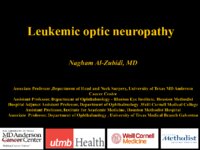 |
Leukemic Optic Neuropathy | Nagham Al-Zubidi, MD | Patient with acute lymphoblastic leukemia presented with left eye vision loss. | Infiltrative Optic Neuropathy; Leukemic Optic Neuropathy; Other Optic Neuropathy |
| 60 |
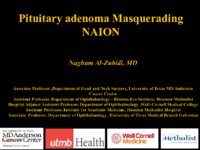 |
Pituitary Adenoma Masquerading as NAION | Nagham Al-Zubidi, MD | Patient 62-year-old male presented with vision loss in the left eye diagnosed with NAION then vision continue to get worse in both eye MRI of the brain showed pituitary adenoma. | Pituitary Adenoma; NAION; Compressive Optic Neuropathy |
| 61 |
 |
Myxopapillary Ependymoma | Nagham Al-Zubidi, MD | A case of filum terminale tumor presented with symptoms and sign of idiopathic intracranial hypertension. | Myxopapillary Ependymoma; Idiopathic Intracranial Hypertension; Filum Terminale Tumor |
| 62 |
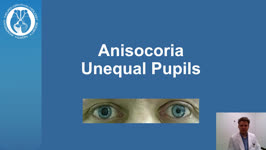 |
Patient Portal: Anisocoria | Nagham Al-Zubidi, MD | Anisocoria is a medical term for unequal pupil size. Normally our pupils are relatively the same size. While small differences in pupil size are normal and can even come and go (physiologic anisocoria), constant and significant differences in pupil sizes may be a sign of damage to the brain or the n... | Anisocoria; Horner Syndrome; 3rd Cranial Nerve Palsy; Adie Tonic Pupil |
| 63 |
 |
Patient Portal: Pituitary Adenoma | Nagham Al-Zubidi, MD | The pituitary gland is a pea-sized gland that sits underneath the base of the brain. It produces and releases many hormones. These hormones control your metabolism, stress level, growth, ovulation and menstruation in women, sperm and testosterone production in men, milk production, and urine product... | Pituitary Adenoma; Pituitary Tumor |
| 64 |
 |
Interpreting Ocular Fundus Photographs: A Brief Guide | Gabriele Berman; Sachin Kedar; Nancy J. Newman; Valerie Biousse | This is a brief guide to the interpretation of the ocular fundus photograph. In this presentation we will describe the structures that comprise the normal ocular fundus followed the abnormalities that can be detected on fundus photographs. By the end of the presentation, learners should be able to d... | Fundus Photograph; Glaucoma; Papilledema; Retinal Detachment |
| 65 |
 |
Retinal Venous Occlusive Disease | Ali Alkhabbaz; James Brian Davis; Amanda Dean Henderson | Retinal venous occlusion (RVO) includes central retinal vein occlusion (CRVO), hemi-central retinal vein occlusion (HCRVO), and branch retinal vein occlusion (BRVO). The most important risk factor for RVO is hypertension, but other risk systemic factors include advanced age and cardiovascular diseas... | Branch Retinal Vein; BRVO; Central Retinal Vein; CRVO; HCRVO; Retinal Venous Occlusion |
| 66 |
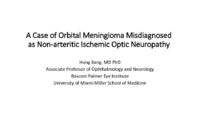 |
A Case of Orbital Meningioma Misdiagnosed as Non-arthritic Ischemic Optic Neuropathy | Hong Jiang, MD, PhD | A 62-year-old woman with hypertension, dyslipidemia, and mild cognitive impairment presented for a second opinion of her left eye visual loss for three months. She initially noticed a black spot in the lower visual field of her left eye and sought care from her local ophthalmologist. At that time, s... | Compressive Optic Neuropathy, Orbit MRI; Orbital Meningioma |
| 67 |
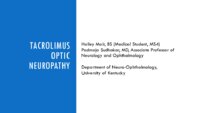 |
Tacrolimus Optic Neuropathy | Hailey Mair, BS; Padmaja Sudhakar, MD | This PowerPoint slide deck will describe tacrolimus optic neuropathy which is a very rare form of optic neuropathy but remains a potential issue in many patients that receive this drug. | Optic Neuropathy; Tacrolimus; Tacrolimus Associated Visual Loss |
| 68 |
 |
Intracerebral Hemorrhage: Classification, Mechanisms, and Principles of Management | William Hills | Intracerebral hemorrhage accounts for approximately 10% of the 795,000 strokes that occur each year in the United States. Mortality is as high as 50% within 30 days of occurrence. There are several types of intracerebral hemorrhages based on inter-cranial location and mechanism. Early aggressive tre... | Epidural Hemorrhage; Intracranial Hemorrhage Management; Intraparenchymal Hemorrhage; Subarachnoid Hemorrhage; Subdural Hemorrhage |
| 69 |
 |
Retinal Artery Occlusive Disease | Ali Alkhabbaz, MD; James Brian Davis; Amanda Dean Henderson, MD | Retinal arterial occlusion includes ophthalmic artery occlusion (OAO), central retinal artery occlusion (CRAO), branch retinal arteriolar occlusion (BRAO), from proximal to distal. These can occur with or without retinal ischemia and may be permanent or transient. There are 4 subtypes of CRAO: non-a... | Branch Retinal Arteriolar Occlusion; Central Retinal Artery Occlusion; Giant Cell Arteritis; Ophthalmic Artery Occlusion |
| 70 |
 |
Raymond Cestan Syndrome | Srujay Pandiri; Sean Gratton | This is a brief narrated powerpoint that explains the clinical presentation of Raymond Cestan Syndrome. This is a rare brainstem stroke syndrome that presents with ipsilateral internuclear ophthalmoplegia and contralateral hemiparesis as well as other features. It is sometimes referred to as upper d... | Brainstem Stroke Syndromes; Internuclear Ophthalmoplegia; Pons |
| 71 |
 |
Vergence Eye Movements | Yu Hsin Chen; Amanda Dean Henderson, MD | Vergence (e.g. convergence and divergence), a class of eye movements that rotates the eyes in opposite directions (disjunctive), serves to hold image on the fovea of both eyes in order to obtain a single, clear image. This presentation overviews the neurology and examinations of vergence response, w... | Convergence; Convergence Insufficiency; Convergence Spasm; Divergence; Divergence Insufficiency |
| 72 |
 |
High Yield Secondary Headaches | Kathleen B. Digre | Lecture and case reports relating to secondary headaches. | Primary Headache; Secondary Headache |
| 73 |
 |
Methanol Toxicity | Daniel Lovasz; James Brian Davis; Amanda Dean Henderson, MD | Methanol toxicity can be very dangerous with high morbidity and mortality rates, and outcomes typically worsen with increasing acidemia, hyperglycemia, or acute kidney injury. Delayed treatment can result in irreversible injury, such as vision loss, or even death. The harmful effects of methanol com... | Acidosis; Fomepizole; Formic Acid; Methanol Toxicity; Toxic Optic Neuropathy |
| 74 |
 |
Natural Language Processing in Neuro-Ophthalmology | Areeba Abid, BS; Sachin Kedar, MD | This video provides an overview of natural language processing (NLP) techniques, applications, and limitations in neuro-ophthalmology. NLP, a branch of artificial intelligence, enables computers to understand and analyze human language. This video discusses three types of NLP techniques: sentiment a... | Artificial Intelligence; Machine Learning; Natural Language Processing; Word Prediction; Word Embeddings; Sentiment Analysis |
| 75 |
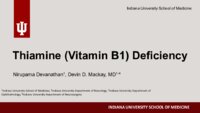 |
Thiamine (Vitamin B1) Deficiency (Presentation) | Nirupama Devanathan; Devin D. Mackay, MD | Overview of thiamine deficiency and its neuro-ophthalmic manifestations with an illustrative case example and discussion of clinical presentation, relevant biochemistry, testing, risk factors, and treatment. Corresponding Video: https://collections.lib.utah.edu/details?id=2297569 | Thiamine; Upbeat Nystagmus; Nutritional Optic neuropathy; Wernicke Encephalopathy |
| 76 |
 |
Thiamine (Vitamin B1) Deficiency (Video) | Nirupama Devanathan; Devin D. Mackay, MD | 33-year-old female who initially presented with heat stroke that was thought to provoke cyclical vomiting over the course of 6 weeks, perpetuated by anxiety, resulting in a 15- pound weight loss. She presented to the ED with bilateral vision loss, bilateral lower extremity weakness and vertical nyst... | Thiamine; Upbeat Nystagmus; Nutritional Optic Neuropathy; Wernicke Encephalopathy |
| 77 |
 |
Acute Idiopathic Blind Spot Enlargement (AIBSE): Case Report | Andrew R. Osborn, MD; James C. O'Brien, MD | We present a single case of Acute Idiopathic Blind Spot Enlargement (AIBSE) in a young female patient, including her clinical course and relevant imaging studies. Her case description is followed by a brief discussion surrounding the current understanding of this rare entity. Associated Images: http... | Acute Idiopathic Blind Spot Enlargement (AIBSE); Outer Retinopathy |
| 78 |
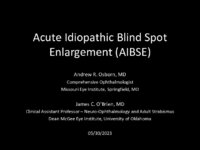 |
Acute Idiopathic Blind Spot Enlargement (AIBSE): Images | Andrew R. Osborn, MD; James C. O'Brien, MD | We present a single case of Acute Idiopathic Blind Spot Enlargement (AIBSE) in a young female patient, including her clinical course and relevant imaging studies. Her case description is followed by a brief discussion surrounding the current understanding of this rare entity. Associated Case Report:... | Acute Idiopathic Blind Spot Enlargement (AIBSE); Outer Retinopathy |
| 79 |
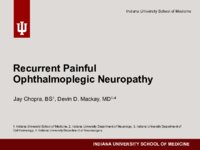 |
Recurrent Painful Ophthalmoplegic Neuropathy | Jay Chopra, BS; Devin D. Mackay, MD | Overview of recurrent painful ophthalmoplegic neuropathy with an illustrative case example and discussion of clinical presentation, possible mechanisms, and treatment. | Recurrent Painful Ophthalmoplegic Neuropathy; RPON; Ophthalmoplegic Migraine; Ophthalmoparesis; Painful Cranial Nerve Palsy |
| 80 |
 |
Therapeutics for Tuberous Sclerosis | Daniel Lovasz; Amanda Henderson, MD | Tuberous Sclerosis Complex (TSC) is a disease characterized by abnormal hamartomas and benign neoplasms in multiple organs. The diagnosis is made by the presence of 2 major features, or 1 major feature accompanied by 2 minor features. These features include various growths in different parts of the ... | Tuberous Sclerosis; Therapeutics; Everolimus; Sirolimus; Hamartomas; mTOR |
| 81 |
 |
Melanoma Associated Retinopathy (MAR) | James O'Brien, MD; Brian Firestone, MD | Grand rounds PowerPoint presentation slides regarding a case of MAR diagnosed at our institution. | Paraneoplastic Syndrome; Melanoma; Retinopathy |
| 82 |
 |
Treatment Outcomes of Ocular Manifestations in Wernicke's Encephalopathy: Case Report | Whitney Stuard Sambhariya, PhD, Medical Student; Melanie Truong-Le, DO, OD | The case of a 28- year-old woman with a past medical history of gastric sleeve who was reported to have blurry vision and presented to neuro-ophthalmology with double vision. On examination the patient had bilateral abducens palsy, alternating upbeat and downbeat nystagmus with a torsional component... | Wernicke's Encephalopathy; Ocular Manifestations; Neuro-ophthalmology; Abducens Palsy; Nystagmus; Double Vision; Blurry Vision |
| 83 |
 |
Treatment Outcomes of Ocular Manifestations in Wernicke's Encephalopathy: Images | Whitney Stuard Sambhariya PhD; Melanie Truong-Le, DO, OD | The case of a 28- year-old woman with a past medical history of gastric sleeve who was reported to have blurry vision and presented to neuro-ophthalmology with double vision. On examination the patient had bilateral abducens palsy, alternating upbeat and downbeat nystagmus with a torsional component... | Wernicke's Encephalopathy; Ocular manifestations; Neuro-ophthalmology; Sbducens palsy; Nystagmus; Double vision; Blurry vision |
| 84 |
 |
Treatment Outcomes of Ocular Manifestations in Wernicke's Encephalopathy: Video | Whitney Stuard Sambhariya, PhD, Medical Student; Melanie Truong-Le, DO, OD | The case of a 28- year-old woman with a past medical history of gastric sleeve who was reported to have blurry vision and presented to neuro-ophthalmology with double vision. On examination the patient had bilateral abducens palsy, alternating upbeat and downbeat nystagmus with a torsional component... | Wernicke's Encephalopathy; Ocular Manifestations; Neuro-ophthalmology; Sbducens Palsy; Nystagmus; Double Vision; Blurry Vision |
| 85 |
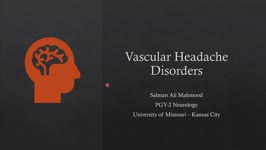 |
Vascular Headache Disorders | Salman Ali Mahmood, MD; Sean Gratton, MD | This is a PowerPoint with embedded audio presenting a detailed summary of the evaluation and management of an important cause of secondary headaches: vascular headache disorders. Topics covered include intracranial hemorrhage, arterial dissection, giant cell arteritis, cerebral venous sinus thrombos... | Vascular Headache Disorders; Epidural Hematoma; Subdural Hematoma; Subarachnoid Hemorrhage; Intracranial Hemorrhage; Arterial Dissection; Giant Cell Arteritis; Cerebral Venous Sinus Thrombosis; Pituitary Apoplexy |
| 86 |
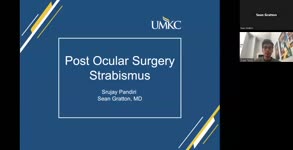 |
A Brief Introduction to Post-Ocular Surgery Strabismus | Srujay Pandiri, Medical Student | This is a short narrated Powerpoint that introduces concepts important to post-ocular surgery strabismus. It highlights the connection between common surgeries include cataract surgery, scleral buckle surgery, refractive surgery, among others. | Diplopia; Strabismus; Post-ocular Surgery Strabismus |
| 87 |
 |
My DEI Journey: Lessons Learned | Ore-ofe Adesina, MD | In this lecture, Dr. Adesina reviews his DEI journey in ophthalmology and the lessons of diversity, equity and inclusion he has learned along the way. He discusses why diversity, equity, and inclusion are all needed for a state of inclusive well-being, why representation matters for patient care and... | Ophthalmology; Diversity, Equity, Inclusion; Representation; Social Determinants of Health |
| 88 |
 |
Metastatic Glioblastoma to Intracranial Optic Nerves, Optic Chiasm and Optic Tracts | Bashaer Aldhahwani, MD; Mariam S. Vilá-Delgado, MD | The patient with pathology confirmed glioblastoma after resectioning the superior frontal lobe tumor followed by 6 weeks of radiation therapy with concurrent temozolomide. The patient started bevacizumab to treat steroid-refractory vasogenic cerebral edema/radiation necrosis. 8 months after radiatio... | Metastatic Glioblastoma; Infiltrative Chiasmal Lesion |
| 89 |
 |
Unilateral Oculomotor Nerve Palsy Secondary to Internal Carotid Artery Aneurysm Without Pupil involvement: A Case Report | Danilo Andriatti Paulo; Richard J Blanch | Acquired oculomotor palsies (OMP) can result from numerous factors. The most common causes are presumed microvascular, trauma, compressive neoplasm, postneurosurgery and compression from aneurysm.1,2 ONP caused by internal carotid artery (ICA) aneurysm is a common clinical manifestation suggesting i... | Unilateral Oculomotor Nerve Palsy; Internal Carotid Artery Aneurysm; Pupil Involvement; Oculomotor Nerve Palsy; Secondary Oculomotor Nerve Palsy |
| 90 |
 |
Uveo-Meningeal Syndromes: Vogt-Koyanagi-Harada (VKH) Disease | Rachana Haliyur, MD, PhD; Emily Cole, MD, MPH; Therese Sassalos, MD; Sangeeta Khanna, MD | Ocular inflammatory symptoms with concurrent neuro-ophthalmologic manifestations can be diagnostically challenging. We provide a general overview of uveo-meningeal syndromes, which comprises a heterogeneous group of disorders that involve inflammation of the uveal tract, retina, and meninges. The pr... | VKH; Vogt-Koyanagi-Harada; Uveomeningeal Syndrome; Ocular Inflammation; Uveitis; CSF Pleocytosis; Serous Retinal Detachments |
| 91 |
 |
Ethambutol Optic Neuropathy | Hailey Mair, BS; Padmaja Sudhakar, MD | This is a PowerPoint slide describing ethambutol induced optic neuropathy and it elaborates on mechanism and vulnearble population. | Ethambutol; Tuberculosis; Optic Neuropathy |
| 92 |
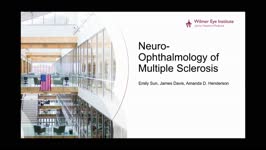 |
Neuro-Ophthalmology of Multiple Sclerosis | Emily Sun, Medical Student; Amanda Henderson, MD | Multiple Sclerosis (MS) is the most common neurological disease in young people with an average age of onset between 15 and 35 years old. MS is an autoimmune inflammatory condition that causes demyelinating lesions in the CNS. The diagnosis is clinical, but MRI is typically used to support the diagn... | Multiple Sclerosis; Optic Neuritis; Uveitis; Internuclear Ophthalmoplegia; Nystagmus; Steroids; Demyelinating; Autoimmune |
| 93 |
 |
Clival Menigioma Causing 6th Nerve Palsy | Bashaer Aldhahwani, MD; Mariam S. Vilá-Delgado, MD | 65 year- old Male patient presented with progressive binocular, horizontal diplopia with limitation of abduction in the right eye. He was diagnosed with Isolated compressive right 6th CN palsy due to right Clival Meningioma. | Clival Meningioma; Sixth Nerve Palsy |
| 94 |
 |
Diagnosis and Evaluation of Stroke: Mechanism - Vasculitis | Danny Alevy; Amanda D. Henderson, MD | In this video, we discuss the diagnosis and evaluation of several vasculitides linked to an increase in risk for cerebral ischemic stroke. We focus on ANCA-associated vasculitides, polyarteritis nodosa, Takayasu arteritis, lupus vasculitis, and Susac syndrome, while highlighting their key symptoms a... | Ischemic Stroke; Vasculitis; ANCA-associated Vasculitis; Polyarteritis Nodosa; Takayasu Arteritis; Systemic Lupus Erythematosus; Susac Syndrome |
| 95 |
 |
Illustrations of the Afferent Visual Pathway and Concepts Surrounding Trans-Synaptic Neuroaxonal Degeneration in the Visual Pathway in Multiple Sclerosis | Olwen C. Murphy; Peter A. Calabresi; Shiv Saidha | Image 1 title: Functionally-eloquent organization of the afferent visual pathway; Image 1 description: The afferent visual pathway is a sensory pathway comprised of 3 neurons. The 1st order neurons are the shortest neurons in the pathway and are entirely unmyelinated. The cell bodies of the 1st orde... | Optic Neuritis; Multiple Sclerosis; Neuroaxonal Degeneration; Trans-synaptic Degeneration; Visual Pathway; Functional Eloquence |
| 96 |
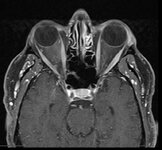 |
Curtain Sign (Enhanced Ptosis) - Associated Image 2 | Bashaer Aldhahwani, MD; Hong Jiang, MD, PhD | This is a 78-year-old male patient who presented with diplopia, right eyelid ptosis, and ophthalmoplegia. He had severe ptosis OD and pseudo-proptosis (lid retraction) OS at baseline, but when the right eyelid was manually elevated, there was marked enhanced ptosis of the left eyelid (Video). He was... | Myasthenia GravIs; Clinical Signs |
| 97 |
 |
Sports Related Head Injuries | Jessica Darusz, MD; Sean Gratton, MD | This narrated PowerPoint reviews the basics of sports related head injuries. It emphasizes assessment tools and treatment decisions in assessing athletes with concussion and other head injuries. | Concussion; Sports-related Head Injuries; Post-concussion Syndrome |
| 98 |
 |
Postconcussion Syndrome and Postconcussion Headache | Jessica Darusz, MD; Sean Gratton, MD | This brief presentation describes the pathophysiology, evaluation, and management of concussion, with an emphasis on postconcussion headache. | Concussion; Postconcussion Syndrome; Postconcussion Headache |
| 99 |
 |
Morning Glory Disc Anomaly | Bashaer Aldhahwani, MD; Carlos Ernesto Mendoza Santiesteban, MD | A colored fundus photo of a patient with morning glory anomaly. Morning glory anomaly is a rare congenital malformation of the optic nerve. The morning glory disc anomaly can be seen with transsphenoidal basal encephalocele. It is known as morning glory syndrome when it is associated with systemic s... | Optic Disc Anomaly |
| 100 |
 |
Curtain Sign (Enhanced Ptosis) | Bashaer Aldhahwani, MD; Hong Jiang, MD, PhD | This is a 78-year-old male patient who presented with diplopia, right eyelid ptosis, and ophthalmoplegia. He had severe ptosis OD and pseudo-proptosis (lid retraction) OS at baseline, but when the right eyelid was manually elevated, there was marked enhanced ptosis of the left eyelid (Video). He was... | Myasthenia GravIs; Clinical Signs |
| 101 |
 |
Curtain Sign (Enhanced Ptosis) - Associated Image 1 | Bashaer Aldhahwani, MD; Hong Jiang, MD, PhD | This is a 78-year-old male patient who presented with diplopia, right eyelid ptosis, and ophthalmoplegia. He had severe ptosis OD and pseudo-proptosis (lid retraction) OS at baseline, but when the right eyelid was manually elevated, there was marked enhanced ptosis of the left eyelid (Video). He was... | Myasthenia GravIs; Clinical Signs |
| 102 |
 |
A Brief Introduction to AI in Neuro-ophthalmology | Areeba Abid, BS; Sachin Kedar, MD | In this video, we describe the basics of artificial intelligence and machine learning as applicable to clinical neuro-ophthalmologists. We use the example from a recent publication, where AI software was used to detect optic disc edema in fundus images. | Artificial Intelligence; Machine Learning |
| 103 |
 |
Optic Nerve Hypoplasia (ONH) - Double Ring Sign | Bashaer Aldhahwani, MD; Joshua Pasol, MD | Optic nerve hypoplasia (ONH) is characterized by a decreased number of optic nerve axons. It can present unilaterally or bilaterally, Isolated or associated with midline cerebral structural defects, such as septum pellucidum absence, agenesis of corpus callosum, cerebral hemisphere abnormalities, or... | Optic Nerve Hypoplasia (ONH) |
| 104 |
 |
Introduction to NANOS NOTE | Karl C. Golnik, MD | Introduction to NANOS NOTE, a resource for non-neuro-ophthalmologists describing common examination techniques. | Neuro-Ophthalmology Examination Techniques |
| 105 |
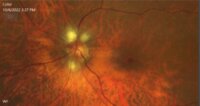 |
Myelinated Retinal Nerve Fiber Layer | Bashaer Aldhahwani, MD; Hong Jiang, MD, PhD | A 78 YOF with no visual symptoms has an incidental finding of yellow-white well-demarcated patches with ragged borders at the peripapillary area of her left eye (see the fundus photo). | Myelinated Retinal Nerve Fiber Layer |
| 106 |
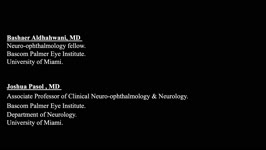 |
Ocular Neuromyotonia Video | Bashaer Aldhahwani, MD; Joshua Pasol, MD | A video demonstrates ocular neuromyotonia in the left eye of a patient with a history of cranial radiation of parasellar mass. Ocular neuromyotonia (ONM) is a rare ocular motor disorder characterized by intermittent, tonic spasms of one or more of the extraocular muscles, resulting in strabismus and... | Ocular Neuromyotonia |
| 107 |
 |
Optic Neuritis | NANOS | In the most common form of optic neuritis, the optic nerve has been attacked by the body's overactive immune system and results in decreased vision. | Optic Neuritis; Patient Brochure |
| 108 |
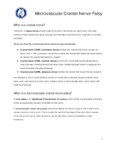 |
Microvascular Cranial Nerve Palsy | NANOS | Microvascular cranial nerve palsy is one of the most common causes of double vision in the older poulation. They are often referred to as "diabetic" palsies. They will resolve without leaving any double vision. | Microvascular Cranial Nerve Palsy; Patient Brochure |
| 109 |
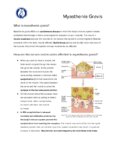 |
Myasthenia Gravis | NANOS | This is an autoimmune condition where the body's immune system has damaged receptors on your muscles and can result in double vision or drooping lid. | Myasthenia Gravis; Patient Brochure |
| 110 |
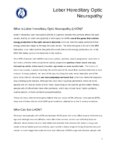 |
Hereditary Optic Neuropathy (Leber's Hereditary Optic Neuropathy) | NANOS | Hereditary Optic Neuropathy - A hereditary optic neuropathy is caused by a genetic variant (or mutation) that causes dysfunction of the neurons (nerve cells) which form the optic nerve. The optic nerve sends information from the back of the eye to the vision center in the brain.The two most common t... | Hereditary Optic Neuropathy; Patient Brochure |
| 111 |
 |
Transient Vision Loss | NANOS | Vision loss that is temporary (transient) is a common problem and has many potential causes.Patients with temporary vision loss often do not have any abnormalities on their eye examination, especially once the vision has returned to normal. | Transient Vision Loss; Patient Brochure |
| 112 |
 |
Cogan Lid Twitch | Hari Anandarajah, BA | A 50-year-old woman presented with ptosis of her left eyelid for 6 months. Several exam findings including variable and fatigable ptosis, and Cogan lid twitch, raised suspicion for Myasthenia Gravis. Acetylcholine receptor binding, blocking, and modulating antibodies were negative, and single fiber ... | Lid Twitch; Myasthenia Gravis |
| 113 |
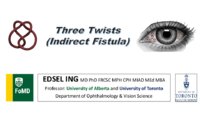 |
Indirect Carotid Cavernous Fistula | Edsel Ing, MD, PhD, FRCSC | A 67-year-old woman had delayed initial diagnosis of her right low flow carotid cavernous fistula (CCF) during the coronavirus disease (COVID-19) pandemic due to difficulty detecting ocular signs via online virtual examinations. Her right eye conjunctival erythema and proptosis with medial rectus en... | Carotid Cavernous Fistula; Misdiagnosis; Radiology |
| 114 |
 |
Giant Cell Arteritis: Diagnostic Prediction Models, Temporal Artery Biopsy and Epidemiology | Edsel Ing MD, PhD FRCSC MPH CPH MIAD MEd MBA, | Giant cell arteritis (GCA) is the most common primary vasculitis in the elderly and can cause irreversible blindness, aortitis, and stroke. Diagnostic confirmation of GCA usually entails temporal artery biopsy (TABx) - a time-consuming and invasive test, or ultrasound. The primary treatment of GCA i... | Giant Cell Arteritis; Diagnostic Prediction Model; Epidemiology; Temporal Artery Biopsy; Differential Diagnosis |
| 115 |
 |
Radiation Optic Neuropathy | Khawla Elnour; Amanda Henderson, MD | A video describing optic neuropathy related to radiation. | Radiation; Neuropathy |
| 116 |
 |
Vogt-Koyanagi-Harada Syndrome | Shwetha Mudalegundi, Medical Student; Amanda D. Henderson, MD | Vogt-Koyanagi-Harada (VKH) syndrome is a rare disorder that affects several body systems. Here we take a broad look at the presentation and pathophysiology of VKH, with a more specific focus on the relevant eye findings. Since much is not known about VKH, we explore the current standards for diagnos... | Vogt-Koyanagi-Harada Syndrome; Uveitis |
| 117 |
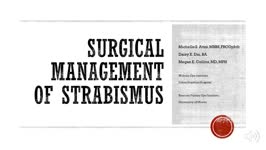 |
Surgical Management of Strabismus | Michelle S. Attzs, MBBS, FRCOphth | This is a brief introduction to the surgical management of strabismus. It includes the key elements of the work up for a patient about to undergo strabismus surgery, introduces the basics on surgical techniques including adjustable sutures, and discusses the complications associated with this surger... | Strabismus; Surgery; Ocular Motility; Adjustable Sutures; Esotropia; Exotropia; Complications |
| 118 |
 |
Direct-Indirect Ophthalmoscopy (DIO) | Irina Krikova, PA-C; Eric Caskey, MD; Alison Crum, MD; Kathleen Digre, MD; James Gilman, CRA, FOPS; Levi Goldfarb, MBA, MD Candidate; Bradley Katz, MD; Ethan Peterson, Videographer; Meagan Seay, DO; Judith Warner, MD | A slideshow describing the use of the direct ophthalmoscope. | Ophthalmoscopy |
| 119 |
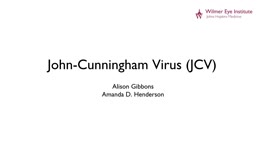 |
John Cunningham Virus | Alison Gibbons; Amanda D. Henderson, MD | This learning object is a narrated Power Point presentation describing the features of, risk factors for, and clinical presentations of the John Cunningham, or JC, virus. It includes a discussion of various immunosuppressed states, including HIV, use of natalizumab (a disease-modifying therapy that ... | John Cunningham Virus; JC Virus; Natalizumab |
| 120 |
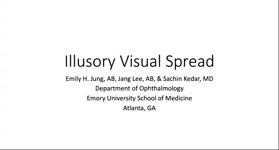 |
Illusory Visual Spread | Emily H. Jung, AB; Jang Lee, AB; Sachin Kedar, MD | Illusory visual spread is a form of visual perseveration resulting in images appearing to spread beyond it normal confines. In this video we describe a patient with Parkinson's disease and dementia, who developed various forms of visual hallucination including palinopsia and illusory visual spread. ... | Visual Perseveration; Illusory Visual Spread; Visual Hallucination |
| 121 |
 |
Corectopia | Meagan Seay, DO | These are photos of a patient with unilateral corectopia. This patient's corectopia is of unclear etiology and possibly related to birth trauma. | Corectopia; Unilateral; Photos |
| 122 |
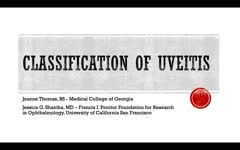 |
Classification of Uveitis | Joanne Thomas, BS; Jessica Shantha, MD | This is an overview of the classification of uveitis. Topics discussed include: SUN anatomic classification, characterization of uveitis descriptors, AC cell and AC flare classification, and terminology of activity. | Uveitis; Classification; SUN |
| 123 |
 |
Voluntary Nystagmus | Sangeeta Khanna, MD | A short presentation on the phenomena of voluntary nystagmus. | Nystagmus; Voluntary Nystagmus |
| 124 |
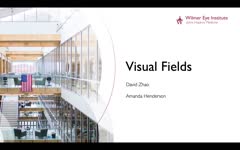 |
Visual Fields | David Zhao; Amanda Henderson, MD | Video presentation covering a thorough overview of visual fields. | Visual Fields |
| 125 |
 |
Nystagmus Elicitation Techniques | Jorge C. Kattah, MD | An examination of the patient days or weeks after the acute event requires fixation block, and a variety of techniques, known as nystagmus elicitation maneuvers to detect the recent vestibular imbalance. | Nystagmus |
| 126 |
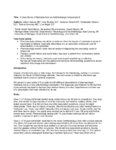 |
A Case Series of Mydriasis from an Anticholinergic Antiperspirant | Aileen Antonio, MD; Inna Bondira, DO; Cameron Holicki, DO; Christopher Glisson, DO; Tatiana Deveney, MD; Lina Nagia, DO | Causes of anisocoria span a wide range, from benign to life-threatening, making it a common indication for Neuro-Ophthalmology referrals. One such cause is related to pharmacologic mydriasis due to direct or systemic exposure. We present a case series of four patients with different presentations of... | Anisocoria; Mydriasis; Pharmacologic Anisocoria; Anticholinergic Antiperspirant |
| 127 |
 |
Anatomic and Physiologic Basis for Gaze Stability | Ariel Winnick and Meagan Seay, DO | Diagram describing the anatomic and physiologic basis of gaze stability. | Gaze Stability |
| 128 |
 |
Sensory Nystagmus | Tony Brune, DO; Jonathan D. Trobe, MD; Raed Behbehani, MD | A video describing sensory nystagmus. | Nystagmus; Sensory Nystagmus |
| 129 |
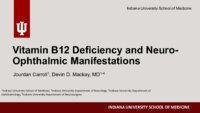 |
Vitamin B12 Deficiency and Neuro-Ophthalmic Manifestations | Jourdan Carroll; Devin D. Mackay, MD | This presentation covers vitamin B12 deficiency, including etiology, signs and symptoms, neurologic and ophthalmic findings, a case presentation and treatment. | Vitamin B12 Deficiency and Neuro-Ophthalmic Manifestations |
| 130 |
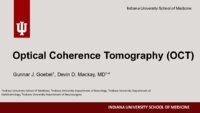 |
Optical Coherence Tomography (OCT) | Gunnar J. Goebel; Devin D. Mackay, MD | Introduction to OCT, including history, principles, interpretation, and applications. | Optical Coherence Tomography (OCT) |
| 131 |
 |
Optical Coherence Tomography Angiography | David Zhao; Amanda Henderson, MD | Video presentation covering a thorough overview of Optical Coherence Tomography Angiography (OCTA). | Optical Coherence Tomography Angiography; OCTA |
| 132 |
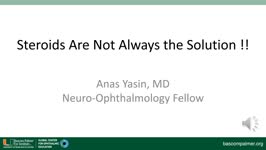 |
Steroids Are Not Always the Solution!! | Anas Yasin, MD | Leber Hereditary Optic Neuropathy (LHON) is the most common inherited mitochondrial disorder and typically affects young males. (https://eyewiki.aao.org/Leber_Hereditary_Optic_Neuropathy) | Leber Hereditary Optic Neuropathy (LHON) |
| 133 |
 |
How to Find Funding Sources | Elizabeth Frakes, MLIS, AHIP | Brief description of funding sources and how to find them. | Funding |
| 134 |
 |
How to Submit an IRB Application | Elizabeth Frakes, MLIS, AHIP | A general outline of the steps involved in submitting an IRB application for research. | Institutional Review Board (IRB) |
| 135 |
 |
Myelinated Retinal Nerve Fiber Layer (MRNFL) | Sparsh Jain, BS; Ryan D. Walsh, MD | Fundus photos demonstrating bilateral (right > left) peripapillary myelinated retinal nerve fiber layer (MRNFL) in a 14-year old boy. Note the typical appearance of MRNFL of a white patch with feathered margins involving the inner retina. In this case, the MRNFL is more prominent in the right eye, a... | Myelinated Retinal Nerve Fiber Layer; MRNFL; Congenital Anomalies |
| 136 |
 |
A Macro Dilemma: Demonstrations of the Anterior Chiasmal Syndrome and Wilbrand's Knee | Ariel Axelbaum, MD; Nurhan Torun, MD | Presentation reviewing two cases that demonstrate several cases of anterior chiasmal syndromes and the variability in patient presentations with sellar masses. | Anterior Chiasmal Syndromes; Masses of the Sella |
| 137 |
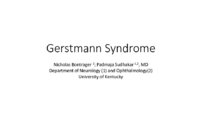 |
Gerstmann Syndrome | Nicholas Bontrager; Padmaja Sudhakar, MD | Gerstmann syndrome refers to a constellation of four neurologic deficits: agraphia, acalculia, finger agnosia , and left-right disorientation. All symptoms must be present for a diagnosis of true Gerstmann syndrome. | Gerstmann Syndrome |
| 138 |
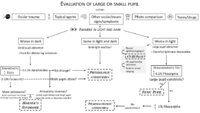 |
Pupil Evaluation Flowchart | Ariel Winnick; Eric Caskey, MD; Meagan Seay, DO | Flow chart outlining the evaluation of large or small pupils. | Pupil Evaluation |
| 139 |
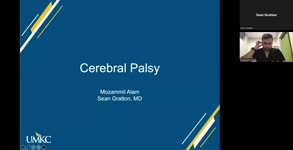 |
Cerebral Palsy | Mozammil Alam, Medical Student; Sean Gratton, MD | This video covers an overview of cerebral palsy. | Cerebral Palsy |
| 140 |
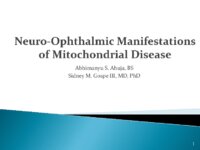 |
Neuro-Ophthalmic Manifestations of Mitochondrial Disease | Abhimanyu S. Ahuja, BS; Sidney M. Gospe III, MD, PhD | Classically, mitochondrial diseases exhibit a maternal inheritance pattern because pathogenic mutations in mitochondrial DNA (mtDNA) are transmitted exclusively via the maternal lineage due to rapid degradation of sperm-derived mitochondria early in embryogenesis. However, mutations in mtDNA may occ... | Mitochondrial Disease; Pathophysiology |
| 141 |
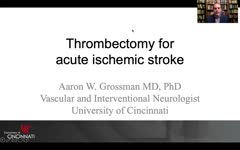 |
Thrombectomy for Acute Ischemic Stroke | Aaron W. Grossman, MD, PhD | A video overview of thrombectomy of acute ischemic stroke. Covers anatomy, history of treatment, and current practice. | Thrombectomy; Acute Ischemic Stroke |
| 142 |
 |
Behcet's Disease | Harinee Arunachalam, MSIV; Sean Gratton, MD | This video provides an overview of Behcet's Disease, a rare vasculitis of unknown etiology. | Behcet's Disease |
| 143 |
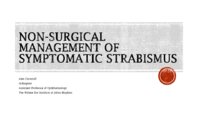 |
Non-Surgical Management of Strabismus | Alex Christoff, MD | An overview of non-surgical treatment of strabismus. | Strabismus |
| 144 |
 |
Pendular vs Jerk Nystagmus | Tony Brune, DO; Daniel R. Gold, DO | A video distinguishing pendular and jerk nystagmus. | Nystagmus; Pendular Nystagmus; Jerk Nystagmus |
| 145 |
 |
Voluntary Nystagmus | Christopher Glisson, DO; Janet Rucker, MD; Melody Merati; Eric Eggenberger, DO | Demonstration of voluntary nystagmus. | Voluntary Nystagmus |
| 146 |
 |
Decompensated Phoria | Alex Christoff, MD | An overview of decompensated phoria and its treatment. | Decompensated Phoria |
| 147 |
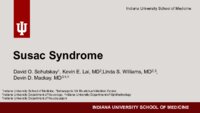 |
Susac's Syndrome | David O. Sohutskay; Kevin E. Lai, MD; Linda S. Williams, MD; Devin D. Mackay, MD | Overview of a case of Susac Syndrome. | Susac Syndrome |
| 148 |
 |
Pupil Exam | Carleigh N. Bruce, MD; Eric D. Habbe, MD; Ryan D. Walsh, MD | This video demonstrates how to conduct a pupillary exam on a patient. Specifically, pupils are evaluated in light and dark conditions, reactivity is assessed, and a swinging flashlight test is used to evaluate for a relative afferent pupillary defect. This video will be most helpful to early ophthal... | Pupil; Examination; Afferent Pupillary Defect; Swinging Flashlight Test; Reactivity |
| 149 |
 |
1% Pilocarpine Testing | Karl C. Golnik, MD | A brief description of using Pilocarpine to test the pupils in patients with anisocoria. | Pharmacological Testing; Pilocarpine |
| 150 |
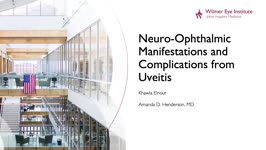 |
Neuro-ophthalmic Manifestations and Complications from Uveitis | Khawla Elnour; Amanda Henderson, MD | An overview of complications of uveitis. | Uveitis; Neuromyotonia |
| 151 |
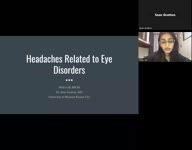 |
Headaches Related to Eye Disorders | Nikki Gill, MSIII; Sean Gratton, MD | Headache attributed to disorders of the eye: Angle closure glaucoma, Ocular inflammation, Refractive error, Trochlear headache, Ocular surface disorder | Eye Disorders; Headache; Angle Closure Glaucoma; Ocular Inflammation; Refractive Error; Trochlear Headache; Ocular Surface Disorder |
| 152 |
 |
Introduction to the Neurological Examination in NANOS NOTE | Padmaja Sudhakar, MD | An introduction to the neurological examination. | Neurology; Neurological Examination |
| 153 |
 |
Introduction to Examination of Eye Movements and Alignment in NANOS NOTE | Jason H. Peragallo, MD | Introduction to Examination of Eye Movements and Alignment | Eye Movement; Alignment; Examination |
| 154 |
 |
Introduction to Diagnostic Tests in NANOS NOTE | Amanda D. Henderson, MD | An introduction to Diagnostic Tests | Diagnostic Testing |
| 155 |
 |
Introduction to Examination of the Pupil in NANOS NOTE | Clare Fraser, MBBS, MMed | Introduction to Examination of the Pupil | Pupil; Examination |
| 156 |
 |
Introduction to Funduscopic Examination in NANOS NOTE | Rahul Sharma, MD, MPH | An introduction to Funduscopic Examination | Funduscopy; Examination |
| 157 |
 |
Introduction to Examination of the Orbit and the Extraocular Structures in NANOS NOTE | Julie Falardeau, MD | Introduction to Examination of the Orbit and the Extraocular Structures | Orbit; Anatomy |
| 158 |
 |
Introduction to the NANOS Neuro-Ophthalmology Techniques of Examination (NOTE) | Karl C. Golnik, MD | An introduction to the NANOS Neuro-Ophthalmology Techniques of Examination (NOTE) | Examination; Eye Exam |
| 159 |
 |
Introduction to Evaluation in Special Situations in NANOS NOTE | John Pula, MD | An introduction to NOTE sections on Examination of the Comatose Patient and Examination of the Pediatric Patient. | Patient Examination; Pediatric Patient; Examination |
| 160 |
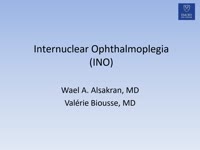 |
Internuclear Ophthalmoplegia | Wael A. Alsakran, MD; Valérie Biousse, MD | A slideshow describing INO; includes a video clip of saccadic delay. | INO |
| 161 |
 |
Botulinum Toxin and Migraine | Benjamin Frishberg, MD, FAAN, FNANOS | A video describing the use of botulinum toxin (Botox) for the treatment of migraine. | Botox; Botulinum Toxin; Migraine |
| 162 |
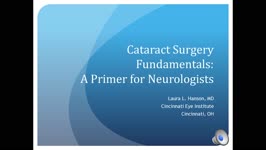 |
Cataract Surgery | Laura L. Hanson, MD | A narrated slide presentation on the basics of cataract surgery. | Cataracts; Surgical Procedures |
| 163 |
 |
Optic Chiasm | Yesha Shah, BSA, BBA; Amanda Henderson, MD | Overview of the anatomy of the optic chiasm. | Optic Chiasm; Anatomy |
| 164 |
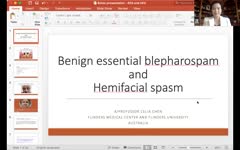 |
Benign Essential Blepharospasm and Hemifacial Spasm | Celia Chen, MBBS, PhD, FRANZCO | Narrated lecture on treatment of benign essential blepharospasm and hemifacial spasm. | Benign Essential Blepharospasm; Hemifacial Spasm |
| 165 |
 |
Complications of Strabismus Surgery and Botox | W. Walker Motley, MD | A narrated video slideshow outlining complications associated with strabismus surgery. | Strabismus; Surgery; Surgical Complications; Botox |
| 166 |
 |
Inferior Orbital Fissure | Yesha Shah, BSA, BBA; Amanda Henderson, MD | Narrated lecture describing the inferior orbital fissure. | Inferior Orbital Fissure |
| 167 |
 |
Practice Based Learning and Improvement (PBLI) | Karl C. Golnik, MD, MEd | Video describing methods and best practices of Practice Based Learning and Improvement (PBLI). | Practice Based Learning and Improvement (PBLI) |
| 168 |
 |
Professionalism and Communication Skills | Karl C. Golnik, MD, MEd | Lecture covering professionalism and communication skills. | Professionalism; Communication Skills |
| 169 |
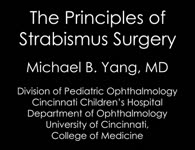 |
Principles of Strabismus Surgery | Michael B. Yang, MD | A video demonstrating a medial rectus recession. | Strabismus; Surgery; Surgery Demonstrations |
| 170 |
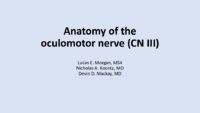 |
Anatomy of the Oculomotor Nerve (CN III) | Lucas E. Morgan, MS4; Nicholas A. Koontz, MD; Devin D. Mackay, MD | A detailed overview of the anatomic course of CN III, including a detailed pathway description and labeled MRI images, gross anatomy pictures, and structural models. | CN III; Third Cranial Nerve; Oculomotor Nerve; Anatomy; MRI |
| 171 |
 |
Visual Maturation | Yesha Shah, BSA, BBA; Amanda Henderson, MD | Video lecture covering visual maturation. | Visual Maturation; Foveal Development; Vision in Infants |
| 172 |
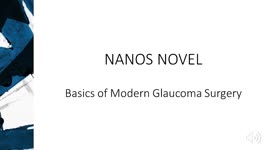 |
Principles of Glaucoma Surgery | Aubrey Tirpack, MD | A video outlining the principles of glaucoma surgery for neuro-ophthalmologists. | Glaucoma; Glaucoma Surgery; Principles of Surgery |
| 173 |
 |
Common Patterns of Visual Field Defects | Sean Gratton, MD; Sarah Lam, 6th year BA/MD | Lecture covering common visual field defects, including those of the retina, optic nerve, chiasm, and retrochiasmal. | Visual Field Defects |
| 174 |
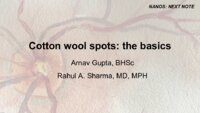 |
Cotton Wool Spots: The Basics | Arnav Gupta, BHSc; Rahul Sharma, MD, MPH | A presentation describing cotton wool spots, an abnormal finding on funduscopic exam of the retina of the eye. | Cotton Wool Spots; Retina |
| 175 |
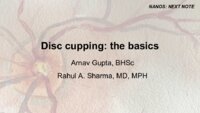 |
Disc Cupping: The Basics | Arnav Gupta, BHSc; Rahul Sharma, MD, MPH | A presentation describing optic disc cupping, due to damage of optic nerve fibres. | Disc Cupping; Optic Disc |
| 176 |
 |
Progressive Supranuclear Palsy (PSP) | Molly Cincotta, MD; Ali G. Hamedani, MD, MHS | Objectives:; To provide an overview of PSP and its pathophysiology;; To present typical clinical features of the disease with a focus on ocular findings;; To provide a template for work up, diagnosis and treatment; ; To demonstrate typical eye movement abnormalities seen in PSP | Progressive Supranuclear Palsy (PSP) |
| 177 |
 |
Computed Tomography (CT): Principles, Technique, and Neuro-ophthalmic Applications | Alex Fraser, MD | Presentation covering Computed Tomography principles, adverse effects, comparison vs. MRI, and assorted examples of neuro-ophthalmic interest. | Computed Tomography (CT) |
| 178 |
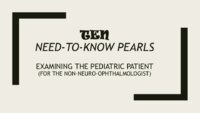 |
Examining the Pediatric Patient for Non-Neuro-ophthalmologists | John Pula, MD | Ten need-to-know pearls for examining the pediatric patient, for non-neuro-ophthalmologists. | Pediatric Patient Exam |
| 179 |
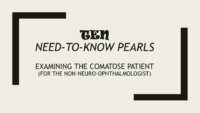 |
Examining the Comatose Patient for Non-Neuro-ophthalmologists | John Pula, MD | Seven need-to-know pearls for examining the pediatric patient, for non-neuro-ophthalmologists. | Comatose Patient Exam |
| 180 |
 |
Visual Fields Part 2: Interpreting The Test Results | Jonathan Trobe, MD | Discussion of interpreting the results of visual field testing. | Visual Fields |
| 181 |
 |
Visual Fields Part 1: Performing The Tests | Jonathan Trobe, MD | Discussion and demonstration of visual field testing. | Visual Fields |
| 182 |
 |
Coordination Exam: Abnormal Examples: Heel-to-shin (x2) (includes Spanish audio & captions) | Paul D. Larsen, MD | The patient with ataxia of the lower extremity will have difficulty placing the heel on the knee with a side-to-side irregular over- and undershooting as the heel is advanced down the shin. Dysmetria on heel-to-shin can be seen in midline ataxia syndromes as well as cerebellar hemisphere disease so ... | Coordination Examination; Heel-shin Test |
| 183 |
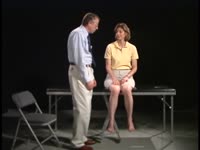 |
Coordination Exam: Normal Exam: Finger-to-nose (includes Spanish audio & captions) | Paul D. Larsen, MD | The patient moves her pointer finger from her nose to the examiner's finger as the examiner moves his finger to new positions and tests accuracy at the furthest outreach of the arm. NeuroLogic Exam has been supported by a grant from the Slice of Life Development Fund at the University of Utah, the D... | Coordination Examination; Finger-to-nose Test |
| 184 |
 |
Coordination Exam: Abnormal Examples: Finger-to-nose (x2) (includes Spanish audio & captions) | Paul D. Larsen, MD | The patient places her heel on the opposite knee then runs the heel down the shin to the ankle and back to the knee in a smooth coordinated fashion. NeuroLogic Exam has been supported by a grant from the Slice of Life Development Fund at the University of Utah, the Department of Pediatrics and the O... | Coordination Examination; Finger-to-nose Test |
| 185 |
 |
Coordination Exam: Normal Exam: Heel-to-shin (includes Spanish audio & captions) | Paul D. Larsen, MD | The patient places her heel on the opposite knee then runs the heel down the shin to the ankle and back to the knee in a smooth coordinated fashion. NeuroLogic Exam has been supported by a grant from the Slice of Life Development Fund at the University of Utah, the Department of Pediatrics and the O... | Coordination Examination; Heel-shin Test |
| 186 |
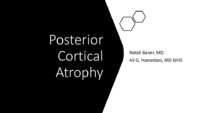 |
Posterior Cortical Atrophy | Natali V. Baner, MD; Ali G. Hamedani, MD, MHS | PowerPoint providing an overview of the definition, clinical presentation and treatment of posterior cortical atrophy | Posterior Cortical Atrophy |
| 187 |
 |
Dementia: Overview and Classification | Molly Cincotta, MD; Whitley Aamodt, MD; Ali G. Hamedani, MD, MHS | PowerPoint providing a broad overview of dementia, including definition, clinical findings, work up, diagnosis, classification, and management. | Dementia |
| 188 |
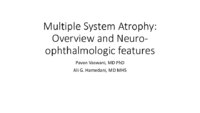 |
Multiple System Atrophy: Overview and Neuro-ophthalmologic Features | Pavan Vaswani, MD, PhD, Movement Disorders Fellow; Ali G. Hamedani, MD, MHS | Objectives: Know the key pathologic features of Multiple System Atrophy; Recognize the clinical presentation, including neuro-ophthalmologic features; Understand the symptomatic therapies and prognosis | Multiple System Atrophy |
| 189 |
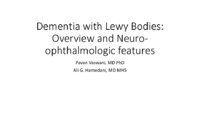 |
Dementia with Lewy Bodies: Overview and Neuro-ophthalmologic features | Pavan Vaswani, MD, PhD; Ali G. Hamedani, MD, MHS | Objectives: Recognize the difference between Dementia with Lewy Bodies and Parkinson disease dementia; Recognize the clinical presentation of DLB and differentiating features from Alzheimer disease dementia; Understand the symptomatic therapies and prognosis | Dementia; Lewy Bodies |
| 190 |
 |
Vascular Dementia | Whitley Aamodt, MD; Ali G. Hamedani, MD, MHS | PowerPoint providing an overview of vascular dementia, including the pathophysiology, clinical symptoms, diagnosis, and management. | Vascular Dementia |
| 191 |
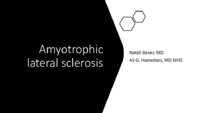 |
Amyotrophic Lateral Sclerosis (ALS) | Natali V. Baner, MD; Ali G. Hamedani, MD, MHS | PowerPoint providing an overview of the definition, clinical presentation and treatment of amyotrophic lateral sclerosis (ALS). | Amyotrophic Lateral Sclerosis (ALS) |
| 192 |
 |
Frontotemporal Dementia: Overview and Neuro-ophthalmologic Features | Pavan Vaswani, MD, PhD; Ali G. Hamedani, MD, MHS | Objectives: Understand the diagnostic criteria for the frontotemporal dementias; Differentiate behavioral variant FTD and the common variants of primary progressive aphasia; Recognize neuro-ophthalmologic and imaging features seen in FTD syndromes | Frontotemporal Dementia |
| 193 |
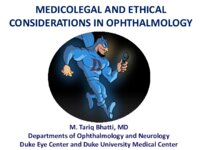 |
Medicolegal and Ethical Considerations in Ophthalmology | M. Tariq Bhatti, MD | Slideshow describing topic. | Ethics; Legal |
| 194 |
 |
Maintenance of Certification Basics: American Board of Psychiatry and Neurology | Sean Gratton, MD | Video lecture covering certification basics. | Credentialing |
| 195 |
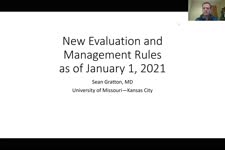 |
New Evaluation and Management Rules for 2021 | Sean Gratton, MD | Overview of the coding rule changes implemented on January 1, 2021. | Coding Rules |
| 196 |
 |
Crafting a Grant Proposal for Research | Silvia Sörensen, PhD | Lecture describing the process of writing a grant for research. | Grant Writing |
| 197 |
 |
Grant Pieces - Research Grants | Silvia Sörensen, PhD | Lecture describing the parts of a research grant, including using human subjects. | Grant Writing |
| 198 |
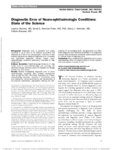 |
Diagnostic Error of Neuro-ophthalmologic Conditions: State of the Science | Leanne Stunkel, MD; David E. Newman-Toker, MD, PhD; Nancy J. Newman, MD; Valérie Biousse, MD | Diagnostic error is prevalent and costly, occurring in up to 15% of US medical encounters and affecting up to 5% of the US population. One-third of malpractice payments are related to diagnostic error. A complex and specialized diagnostic process makes neuro-ophthalmologic conditions particularly vu... | Diagnostic Errors |
| 199 |
 |
Protecting Human Subjects in Biomedical Research | Lisa R. Latchney, MS, CCRC | PowerPoint discussion of the history and development of ethics regulations in health research. | Ethical Issues in Research; Consent |
| 200 |
 |
Manuscripts: You Can Write These! | Elaine Smolock, PhD | Overview of writing techniques and parts of the manuscript, basic approach to writing results sections, what makes a good introduction, crafting a meaningful discussion, abstract and title suggestions, and how to get your editor's attention. | Writing Techniques |
